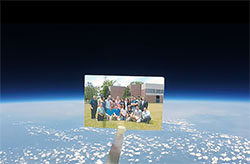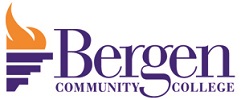
STEM students and faculty attached a photograph of themselves to the high altitude balloon.
PARAMUS, N.J. – Bergen Community College students completed a space odyssey this summer, launching a high altitude balloon to photograph images of the Earth at approximately 96,000 feet. The College’s STEM Student Union and faculty advisers spent more than a year developing the project and preparing for the launch.
“STEM education remains critically important for the United States and the country’s leading role in the global economy,” Bergen Vice President of Academic Affairs William Mullaney, Ph.D., said. “Preparing students for entry into these fields continues to stand at the top of the College’s strategic priorities. Projects like this summer’s high altitude balloon launch reflect the complex teaching and learning taking place at our institution in STEM fields.”
The project, the brainchild of physics professor Paul Griffo, of Rutherford, took more than two years to complete.
Last summer, a power failure shortly after liftoff knocked out the payload’s instruments, dooming a successful first attempt. Undaunted, the team returned to the laboratory intent on the realization of the goal.
With the use of drones, video and a smaller tethered balloon, the team completed three test flights this summer, setting the stage for an Aug. 9 launch at Lackawanna State Park in Pennsylvania.
The balloon, outfitted with two video cameras, a microprocessor programmed to collect data on air pressure, temperature and acceleration, several GPS tracking devices and even a homemade “selfie-stick” with a photograph of the team affixed to it, enabling the group to capture an image of themselves “in” space, topped out at approximately 96,000 feet – essentially the height of the maximum concentration of the ozone layer. Team members believe the balloon would have soared even higher if not for a miscalculation in the weight of the payload – the group did not account for the mass of the string keeping the balloon attached to the instruments. The team plans to travel to Rutgers University next month to present its results.
Retrieval proved tricky, as the balloon crashed back to Earth about an hour after bursting – and more than two miles from the forecasted landing site. The team trekked through deep forest, rugged trails and insect nests before locating the once-airborne cargo.
The team hopes to launch another balloon next year during a total solar eclipse Aug. 21.
Balloon project team members are: students William J. Courchaine, of Lyndhurst, Nicholas Jankowski, of Lyndhurst, Peter Lehrer, of Leonia, Patrick Menchavez, of Fair Lawn and Sofia Galindo Mendoza, of Hillsdale; professors Joseph Sivo, Ph.D., of Fair Lawn, and Griffo; and STEM GPS Director Luis De Abreu, of Hackensack.
Focus on STEM continues at Bergen as the federal government estimates U.S. employers will add nine million STEM jobs by 2022. In 2011, the College secured a $3.8 million U.S. Department of Education grant to fund the Graduation Pathway to Success Project, a five-year initiative to prepare STEM students for graduation, transfer to four-year schools and entry to professional fields.
Projects at Bergen have included converting a softball field house into a workshop and conducting experimental testing with two wind turbines and a solar panel system.
Earlier this year, the Federal Aviation Administration granted Bergen clearance to operate unmanned aerial vehicles (drones) on campus, making it one of only three community colleges to receive such an exemption from the federal government. The exemption will allow the College to enter the U.S. National Airspace System and offer educational programs featuring the operation of the popular technology.
Based in Paramus, Bergen Community College (www.bergen.edu), a public two-year coeducational college, enrolls 15,000 students at locations in Paramus, the Philip Ciarco Jr. Learning Center in Hackensack and Bergen Community College at the Meadowlands in Lyndhurst. The College offers associate degree, certificate and continuing education programs in a variety of fields. More students graduate from Bergen than any other community college in the state.
# # #
